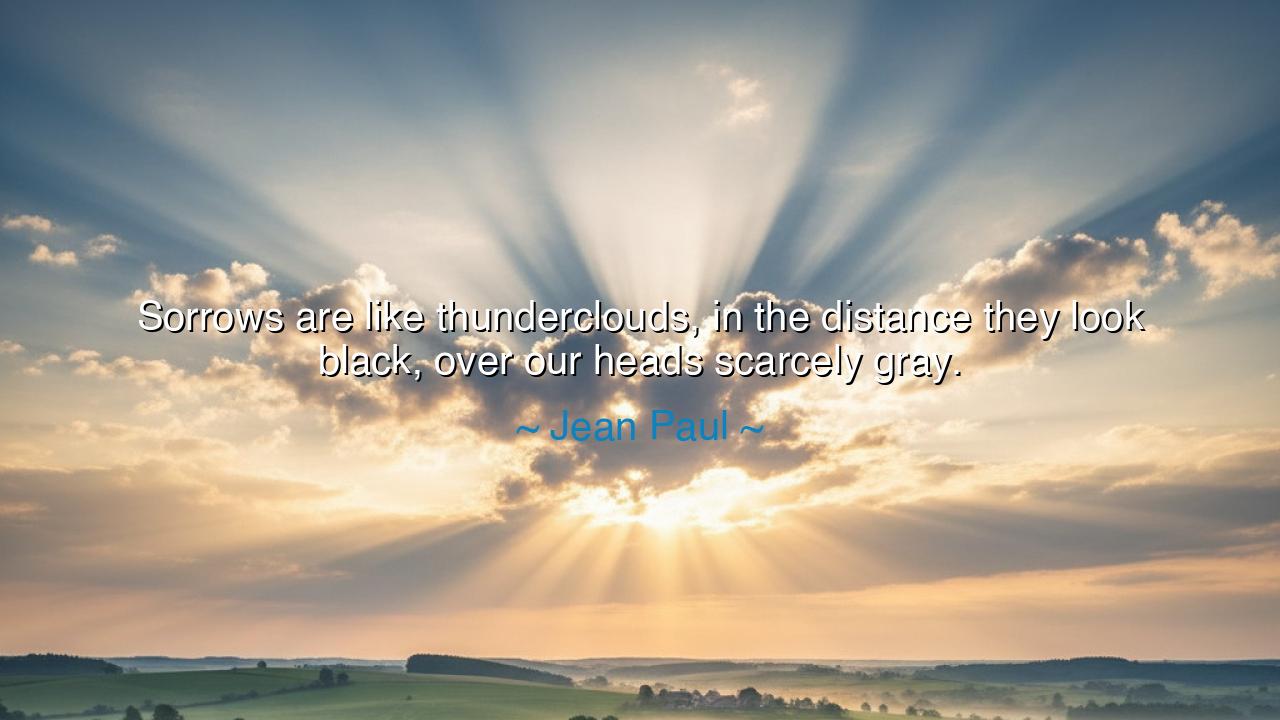
Sorrows are like thunderclouds, in the distance they look black
Sorrows are like thunderclouds, in the distance they look black, over our heads scarcely gray.






In the serene and contemplative words of Jean Paul, we find a truth as soft as dawn and as enduring as the mountains: “Sorrows are like thunderclouds; in the distance they look black, over our heads scarcely gray.” This wisdom, born from the heart of a poet and philosopher, speaks to the illusions of fear and the quiet courage found in facing life’s storms. It reminds us that sorrow, when seen from afar, seems immense, threatening, and unbearable—but when we meet it with courage, its power often fades. The imagination paints our suffering darker than it truly is, yet the reality of pain, when borne with grace, is lighter than our fear ever predicted.
Jean Paul, the German Romantic writer, was no stranger to sorrow. His life was marked by poverty, struggle, and loneliness, yet from his trials he drew deep insight into the human heart. His words reveal the ancient truth that perception shapes our pain more than pain itself. When we gaze into the future and see troubles approaching, they loom like black thunderclouds—heavy with dread, charged with lightning. Yet when the storm finally arrives, it often passes quickly, its roar gentler than we imagined. The heart trembles more from anticipation than from the storm itself.
In the teachings of the ancients, this wisdom was well known. The Stoics, such as Seneca and Epictetus, warned against the tyranny of imagined suffering. Seneca wrote, “We suffer more in imagination than in reality.” The mind, left unguarded, is a magnifier of pain; it sees distant shadows as monsters. Yet when we stand within the moment—when the storm is no longer an idea but a present reality—we often discover a quiet strength we did not know we possessed. Jean Paul’s thundercloud is the perfect image of this truth: that distance multiplies dread, while presence dissolves it.
Consider the tale of Helen Keller, who, blinded and deaf at a young age, faced a life that to others seemed covered by darkness. To the world, her fate looked like a black thundercloud—tragic, impossible, full of despair. Yet within her own experience, she found not endless night, but light. With courage and guidance, she learned to communicate, to learn, to inspire millions. For her, sorrow was not black—it was gray, and even streaked with silver. From her hardship, she discovered joy. Her story is the living embodiment of Jean Paul’s vision: that what appears terrible from afar may, when faced with heart and hope, lose its power to terrify.
There is also a quiet humility in this teaching. Sorrow, like a storm, comes and goes. It is part of the rhythm of existence. When it is distant, we fear it; when it is near, we learn from it. The ancients understood that the wise do not flee from suffering, nor do they exaggerate its weight—they meet it as they would meet the rain, knowing that no storm lasts forever. The blackness we see on the horizon is but a trick of the light, and the soul that walks forward will often find that the clouds, when reached, are thinner than they seemed.
From this we draw a timeless lesson: face your fears, and they will fade. The dread of tomorrow is often worse than tomorrow itself. When sorrow threatens, do not let imagination rule the heart. Step forward, slowly, bravely, into the storm. Look up, not down. Feel the wind, the rain, the weight of the moment—and you will find that the thundercloud above you is not black at all, but soft gray, even touched with light. For courage transforms perception, and the heart that stands firm in the storm learns to see beauty even in the rain.
So remember, O listener: life will always bring its thunderclouds, yet do not let their distant darkness deceive you. Walk toward them, and they will thin. Face your fears, and they will fall silent. As Jean Paul teaches, the shadows of sorrow are darkest only when we are far from them. Once beneath them, they are gentler, lighter, more human. Therefore, do not live in fear of storms—live in readiness for them. For when you meet your sorrow with calm, you will find that even the blackest clouds, once touched by the light of courage, turn to gray—and from gray, to gold.






AAdministratorAdministrator
Welcome, honored guests. Please leave a comment, we will respond soon